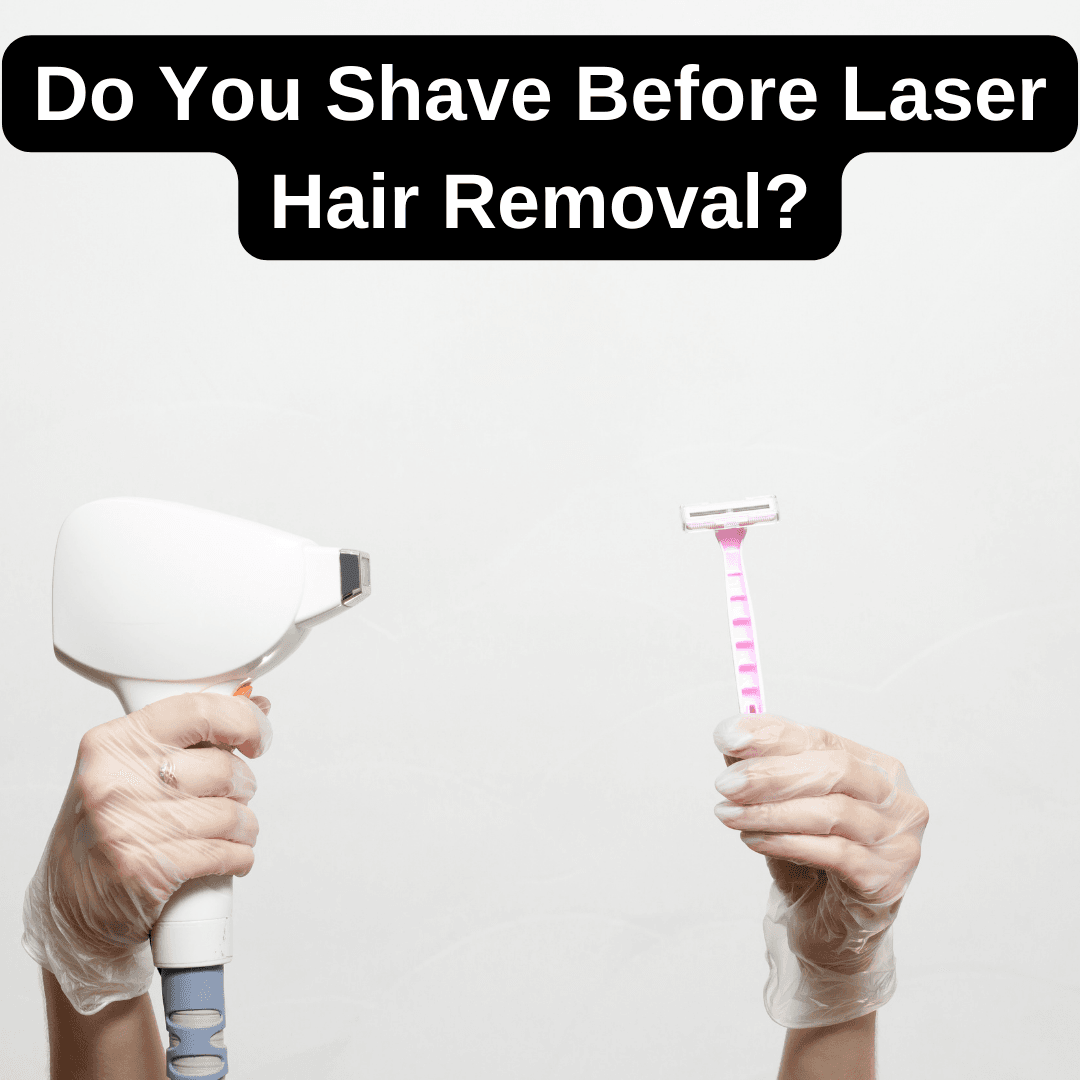Shaving before laser hair removal is an essential step that ensures the laser effectively targets the hair follicles while protecting the skin from irritation and burns. When the hair is shaved down to the surface, the laser can penetrate the follicle more accurately, minimizing the risk of overheating and skin damage. Skipping this step can result in less effective treatment, increased discomfort, and the possibility of skin irritation. To get the most out of your laser hair removal sessions, shaving the treatment area 24 hours before the procedure is highly recommended. This process ensures that the hair is at the ideal length for the laser to work efficiently, promoting smoother skin and long-lasting results.
Why Shaving Before Laser Hair Removal Is Important
Shaving before laser hair removal is essential because the laser targets the pigment in the hair follicle. If the hair is too long, the laser may burn the hair above the skin’s surface, causing discomfort and reducing the treatment’s effectiveness. Properly shaved hair ensures the laser reaches the follicle directly without causing unnecessary irritation.
Benefits of Shaving Before Laser Treatment
- Prevents Surface Burns: Shaving removes excess hair above the skin, reducing the risk of burns.
- Enhances Laser Effectiveness: Shorter hair allows the laser to focus on the follicle, ensuring better results.
- Reduces Discomfort: Shaving minimizes heat absorption on the skin’s surface, making the procedure less painful.
For more insights into how long a full body laser hair removal session typically takes, read our guide on how long does full body laser hair removal take.
How to Properly Shave Before Laser Hair Removal
Shaving correctly before laser hair removal is key to ensuring that the treatment is both safe and effective. A well-prepared skin surface allows the laser to target the hair follicle precisely, reducing the risk of burns, irritation, and uneven results. To prepare for a successful session, follow these detailed steps:
- Use a Clean, Sharp Razor:
Always use a new or sharp razor to ensure a close, smooth shave. A dull blade can cause irritation, leave behind uneven hair, and increase the risk of cuts or infection, which can lead to discomfort during the laser treatment. - Shave 24 Hours Before Treatment:
Shave the treatment area at least 24 hours before your session. This timing gives the skin enough time to recover, reducing the chances of irritation, redness, or sensitivity during the procedure. Shaving immediately before the session can leave the skin too sensitive, which may result in discomfort during treatment. - Shave in the Direction of Hair Growth:
To minimize the risk of ingrown hairs, shave gently in the direction of hair growth. Shaving against the grain can irritate the skin and cause small cuts, which can interfere with the effectiveness of the laser and increase the likelihood of redness or swelling. - Avoid Harsh Shaving Products:
Skip shaving creams or gels with harsh chemicals, fragrances, or alcohol, as these ingredients can irritate the skin and cause sensitivity. Opt for a mild, fragrance-free shaving gel or cream that helps the razor glide smoothly over the skin while preventing irritation. - Moisturize After Shaving:
After shaving, apply a gentle, fragrance-free moisturizer to keep the skin hydrated and reduce sensitivity. Well-moisturized skin is less likely to develop irritation or redness after the laser session. However, avoid using heavy or oily lotions that can clog pores, as they may interfere with the laser’s effectiveness.
By following these steps, you ensure that your skin is properly prepared for laser hair removal, maximizing the effectiveness of the treatment while minimizing the risk of discomfort and side effects.
Comparison of Hair Removal Methods Before Laser Treatment
| Method | Suitable Before Laser? | Reason |
| Shaving | Yes | Preserves the follicle for laser targeting |
| Waxing | No | Removes the follicle, making laser ineffective |
| Plucking | No | Interferes with laser treatment effectiveness |
Shaving Timeline for Laser Hair Removal
| Step | Timing | Importance |
| Shave Before Laser | 24 hours before session | Allows the laser to target the follicle effectively |
| Avoid Shaving Right Before | Same day of session | May cause skin sensitivity |
| Shave After Laser | 4-5 days post-treatment | Reduces the risk of irritation and ingrown hairs |
Shaving and Skin Types: Preparing Based on Skin Sensitivity
Proper shaving techniques vary based on skin type, and taking these factors into account helps prevent irritation and ensure optimal results from laser hair removal. The Fitzpatrick Skin Type Scale categorizes skin into six types, ranging from fair to dark, based on melanin content and reaction to sun exposure. Understanding these types can help tailor the shaving routine to minimize the risk of irritation or adverse reactions.
Fitzpatrick Skin Type Overview
- Type I-II: Fair skin that burns easily and tans minimally.
- Type III-IV: Medium skin that tans gradually and burns moderately.
- Type V-VI: Darker skin that tans easily and rarely burns.
Shaving Tips Based on Skin Type
- For Sensitive Skin (Type I-II):
- Use fragrance-free, hypoallergenic shaving gels to avoid irritation.
- Moisturize with a soothing, non-comedogenic lotion after shaving to reduce redness and sensitivity.
- For Medium Skin (Type III-IV):
- Opt for a mild shaving gel with aloe vera to soothe the skin.
- Avoid shaving too frequently to prevent ingrown hairs or sensitivity.
- For Darker Skin (Type V-VI):
- Use a sharp razor to minimize friction and reduce the risk of hyperpigmentation.
- Apply a lightweight, non-greasy moisturizer after shaving to maintain hydration and prevent dryness.
By adjusting shaving techniques based on skin type, clients can minimize the risk of irritation and improve the effectiveness of their laser hair removal sessions.
What Happens If You Don’t Shave Before Laser Hair Removal?
Failing to shave before laser hair removal can lead to unwanted complications and discomfort. When the hair is too long, the laser targets the hair shaft above the skin, causing burns and making the treatment less effective.
Neglecting to shave properly can increase the risk of irritation and discomfort, similar to what happens when experiencing laser hair removal side effects.
Can You Get Laser Without Shaving?
No, shaving before laser hair removal is a mandatory step for ensuring safe and effective results. Without shaving, the laser cannot properly target the hair follicle, as surface hair absorbs the laser’s heat, increasing the risk of burns, discomfort, and skin irritation. This also makes the treatment less effective because the energy is dispersed across the surface hair instead of reaching the follicle.
If you forget to shave, some clinics may offer to shave the area for an additional fee, but others may reschedule your appointment to ensure the treatment is performed correctly.
Additionally, leaving surface hair intact can cause scorching or singeing during the procedure, which may lead to redness, blistering, or discomfort. Shaving ensures that the laser can effectively focus on the follicle beneath the skin, maximizing the treatment’s efficiency and reducing the likelihood of side effects.
To learn more about potential pain levels and discomfort during laser sessions, check out our article on does laser hair removal hurt.
Can You Wax or Pluck Before Laser Hair Removal?
No, waxing, plucking, or using depilatory creams before laser hair removal is strongly discouraged because these methods remove the hair follicle entirely. Since the laser works by targeting the pigment (melanin) in the hair follicle, removing it beforehand prevents the laser from effectively disabling future hair growth. Waxing and plucking also increase the likelihood of skin irritation, making the treatment less effective and potentially painful.
Shaving is the only recommended method of hair removal before laser treatment because it preserves the hair follicle while keeping the surface hair short enough for the laser to precisely target the root. For a detailed comparison between waxing and other methods, explore our article on is waxing better than epilator.
What If I Forgot to Shave Before Laser Hair Removal?
If you forgot to shave before your laser hair removal session, notify your technician immediately. Most clinics have strict policies regarding unshaven treatment areas. Some clinics may offer to shave the area for you, but this often comes with an additional fee. In other cases, you may need to reschedule the appointment to avoid compromising the results or causing discomfort.
Why is shaving important? If you don’t shave, the laser can burn surface hair, which not only reduces the treatment’s effectiveness but can also cause skin irritation, discomfort, and even minor burns. Always confirm with your clinic about their policy if you arrive unshaven to avoid unexpected surprises.
Post-Treatment Care: Can You Shave After Laser Hair Removal?
Shaving after laser hair removal requires careful timing and technique to ensure that the skin remains smooth, irritation-free, and continues to respond well to treatment. Although it’s normal to see some hair regrowth after a session, avoid shaving immediately afterward to prevent discomfort or skin sensitivity.
How Soon Can You Shave After Laser Hair Removal?
Wait 4-5 days after your laser hair removal session before shaving. This allows the skin to heal and reduces the risk of irritation, redness, or inflammation. Shaving too soon can cause micro-abrasions, leading to discomfort and delaying the skin’s natural recovery process.
When you do shave:
- Use a clean, sharp razor to minimize irritation.
- Avoid using harsh shaving gels or creams that can irritate the treated area.
- Shave gently in the direction of hair growth to prevent ingrown hairs and sensitivity.
By waiting the appropriate amount of time and using proper techniques, you can maintain smooth skin between laser sessions without compromising your results. If you’re unsure when to exfoliate after your sessions, read our guide on when to exfoliate after laser hair removal.
By following proper post-treatment care guidelines, you can maintain smooth skin and prolong the results. For more detailed information about laser hair removal and aftercare, you can visit the official website of Laser Clinics UK.
FAQ: Additional Questions About Shaving and Laser Hair Removal
Can I Use an Electric Razor Before Laser Hair Removal?
Yes, using an electric razor is acceptable, but make sure it trims the hair as close to the skin as possible for the best results. Electric razors may not provide as close a shave as traditional razors, which can affect the laser’s ability to target the follicle effectively. If using an electric razor, go over the area twice to ensure the hair is cut as short as possible.
Is It Safe to Shave Between Laser Hair Removal Sessions?
Yes, shaving between sessions is safe and recommended. Since laser hair removal targets hair in the active growth phase (anagen), shaving between treatments does not interfere with the results. However, avoid using methods like waxing, plucking, or threading, as they disrupt the follicle and reduce the laser’s effectiveness.
What Happens If I Shave Too Soon After Laser Hair Removal?
Shaving too soon after a laser hair removal session can irritate the skin and increase the risk of redness, sensitivity, and micro-abrasions. It’s best to wait 4-5 days after treatment to allow the skin to heal properly. Shaving prematurely may also cause ingrown hairs or discomfort.
Does Shaving Before Laser Hair Removal Affect the Number of Sessions?
No, shaving before laser treatment does not increase the number of sessions required. Proper shaving ensures that the laser targets the follicle directly, making the treatment more effective. The number of sessions depends on factors like hair color, skin type, and the treatment area, but shaving correctly helps maintain consistency in results.
Can I Use Aloe Vera After Shaving and Laser Hair Removal?
Yes, applying aloe vera gel after shaving or laser hair removal helps soothe the skin, reduce redness, and prevent irritation. Aloe vera’s anti-inflammatory properties can accelerate skin healing and provide a cooling effect after treatment. Use pure aloe vera gel without added fragrances or chemicals for the best results. For natural skincare tips that promote healthy skin, read about the benefits of rose water after laser treatments.
How Do I Know If I Shaved Correctly Before Laser Hair Removal?
You’ll know you shaved correctly if the surface hair is completely removed, but the follicle remains intact. The skin should feel smooth with no visible stubble, allowing the laser to target the follicle without burning any surface hair. Double-check the area under good lighting to ensure an even shave. Understanding how laser technology works can help you achieve better results. Learn more in our guide on how laser hair removal works.
Can I Apply Sunscreen After Shaving and Laser Hair Removal?
Yes, sunscreen is essential after laser hair removal. Apply a broad-spectrum SPF 30 or higher to protect the treated area from sun exposure. Sunburn or excessive UV exposure after treatment can cause pigmentation changes and sensitivity. It’s best to apply sunscreen daily and avoid direct sunlight for at least a week post-treatment.
Can I Shave After Every Laser Session?
Yes, you can shave between laser sessions, but avoid shaving immediately after each treatment. Wait at least 4-5 days before shaving to give the skin enough time to recover. Consistent shaving between sessions helps maintain a smooth texture and prepares the area for future treatments.
How Many Times Should I Shave Between Laser Sessions?
Shaving between laser sessions is essential to maintain smooth skin and prevent any interference with the treatment process. However, over-shaving can lead to skin irritation and increased sensitivity. After your first laser session, wait 4-5 days before shaving. After this initial period, shaving every 3-4 days between sessions is sufficient to maintain smooth skin.
Shave Every 3-4 Days for Optimal Results:
Shaving every 3-4 days between laser sessions is generally sufficient to keep the treatment area smooth while preventing ingrown hairs or discomfort. This frequency allows the skin enough time to recover from each shave, minimizing the risk of irritation and ensuring that the area remains properly prepared for subsequent laser treatments.
Why Shaving Between Sessions Is Important:
- Prevents Ingrown Hairs: Regular shaving reduces the risk of ingrown hairs, which can cause discomfort and disrupt the treatment area.
- Keeps the Skin Smooth: Maintaining a smooth surface ensures the laser effectively targets hair follicles during follow-up sessions.
- Enhances Laser Effectiveness: Consistent shaving prevents surface hair from absorbing the laser’s energy, allowing the laser to focus on the follicle directly.
For best results, avoid shaving immediately after a laser session and wait at least 4-5 days to allow the skin to heal. Consistency in shaving between sessions helps maximize the effectiveness of the laser treatment, leading to smoother skin and long-lasting results.
Maintaining consistent shaving between sessions ensures better results, much like understanding how long laser hair removal lasts.
Can I Shave Every Day Before Laser Hair Removal?
Shaving every day before laser hair removal is not recommended. While it’s essential to keep the treatment area hair-free, over-shaving can cause skin irritation, dryness, and increased sensitivity. When the skin is irritated before laser treatment, it becomes more prone to redness, itching, and discomfort during the session.
Why You Should Avoid Daily Shaving:
- Increased Skin Sensitivity: Daily shaving can lead to micro-abrasions, making the skin more sensitive and prone to irritation during the laser procedure.
- Higher Risk of Ingrown Hairs: Frequent shaving increases the likelihood of ingrown hairs, which can cause discomfort and inflammation, potentially interfering with laser effectiveness.
- Reduced Treatment Efficiency: Over-shaved or irritated skin may absorb more heat during the procedure, leading to an increased risk of burns or hyperpigmentation.
Does Shaving Before Laser Make It Less Effective?
No, shaving before laser hair removal does not reduce the effectiveness of the treatment. In fact, proper shaving enhances the laser’s ability to target the hair follicle effectively. Shaving removes the surface hair while leaving the root intact, allowing the laser to focus on the follicle and destroy it without interference.
Why Shaving Improves Laser Effectiveness:
- Targets Follicle Directly: Shaving ensures that the laser’s energy is directed at the hair follicle beneath the skin, maximizing its effectiveness.
- Prevents Heat Absorption on Surface Hair: Without surface hair absorbing the laser’s energy, the follicle receives the full intensity needed to disable future growth.
- Minimizes Skin Irritation: A properly shaved area prevents heat buildup on the skin’s surface, reducing discomfort and the risk of burns.
What Are the Long-Term Benefits of Proper Shaving Before Laser?
Shaving correctly before laser hair removal does more than just prepare the skin for a smoother session — it contributes to long-term success and optimal results. Proper shaving practices ensure that the laser effectively targets the follicle without interference, maximizing the treatment’s effectiveness. Over time, consistently shaving the right way before your sessions can provide multiple long-term benefits, including:
1. Faster and More Noticeable Results
When the treatment area is shaved properly, the laser can penetrate the follicle more precisely, reducing the number of sessions required to achieve desired results. Inconsistent or improper shaving can delay results, as surface hair may absorb the laser’s energy, preventing it from effectively reaching the follicle.
2. Reduced Risk of Ingrown Hairs
Ingrown hairs are a common issue for many individuals, especially in sensitive areas like the bikini line and underarms. Proper shaving before laser hair removal minimizes the risk of ingrown hairs by ensuring that the hair is cut close to the surface without disturbing the follicle. As laser treatment progresses, hair growth reduces, further lowering the likelihood of ingrown hairs.
3. Less Skin Sensitivity Over Time
Shaving too aggressively or using improper techniques can lead to skin irritation, making the treated area more prone to redness, bumps, and inflammation. However, by adopting proper shaving methods — such as using a clean razor, shaving in the direction of hair growth, and moisturizing after shaving — the skin becomes more resilient over time, reducing sensitivity after each session.
4. Smoother Skin Between Sessions
Proper shaving not only enhances the effectiveness of laser treatment but also maintains smoother skin between sessions. Since the laser targets the hair follicle, consistent and correct shaving practices help ensure that the skin remains soft and free of irritation, promoting an even texture throughout the treatment process.
5. Fewer Touch-Up Sessions in the Future
By following the correct shaving routine, clients can achieve better and more consistent results, reducing the need for frequent touch-up sessions after completing the initial treatment plan. Proper preparation allows the laser to effectively disable hair follicles, minimizing regrowth and ensuring long-lasting smoothness.
6. Better Overall Skin Health
When shaving correctly before laser hair removal, the risk of irritation, burns, and inflammation is significantly reduced. This promotes healthier skin over time, preventing long-term skin damage and ensuring that the treated area remains smooth and free from complications.
Incorporating these proper shaving practices consistently enhances the effectiveness of laser hair removal and leads to lasting, smooth, and irritation-free skin. By prioritizing proper preparation, you can enjoy smoother, healthier skin with minimal maintenance after completing your treatment plan.
Long-term benefits of consistent shaving before laser treatment can also help reduce skin concerns, similar to the effects discussed in how to prevent ingrown hairs after waxing.

Board-Certified Aesthetic Specialist & Certified Laser Technician
She is a board-certified aesthetic specialist with 14+ years of experience in laser hair removal, skincare, and full-spectrum beauty services. Holding academic training in beauty sciences and advanced certifications, she blends medical-grade knowledge with personalized care. At Epilation World, her mission is to empower readers with clear, ethical, and research-backed insights that support confident personal care decisions.





